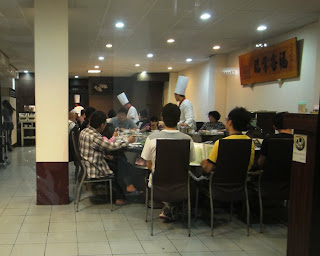
I am often puzzled by the Taiwanese question of “Is it famous?” when it comes to demarcating the merits of something. It’s famous therefore it’s good is not the soundest argument known to mankind and indeed you do not need to be Descartes to blow the theory apart. McDonald’s, Blue Nun wine and the sitcom Friends are all famous. Hsinchu’s very own Gothenburg nightclub is famous (within Hsinchu) and the words that go with it are generally “shame” “drunken” and “where else can we go at this hour?”. But I will save this Pandora ’s Box for another review.
The opposite can be said for Hong Xi teppanyaki. As far as I know, this gem of a restaurant is hiding its light under the large bushel of Beida Road as most locals do not seem to know of its existence. Teppanyaki originates from Japan (teppan means iron plate and yaki can be roughly translated as grilled – hence the food is grilled on an iron plate) and there are many dotted around Taiwan, possibly a nod to the former relations between the two countries. Think Benihana minus the theatrical shenanigans and you have Taiwanese teppanyaki. The options at Hong Xi range from varying thicknesses of beef, lamb and pork to sublime fish and prawns.
Ok, so far not too different from most other Taiwanese teppanyaki restaurants. What makes Hong Xi worth a trip to Hsinchu is the attention to quality. The food is cooked with less oil, giving it a cleaner flavour and saving your arteries a few more hours of life. Fish are de-boned, prawns are served sans-shell and the meat is cooked to perfection. Added to this is an interesting selection of side dishes including, crabs, oysters and other seafood, cheese eggs and onion eggs (the egg is cooked within a raw onion ring, giving a soufflé texture).
Hong Xi has also been renovated recently, with a sleek dark wooden theme running throughout the restaurant. A newly opened second floor gives diners a quieter area to enjoy their food and also provides additional seating during peak hours. Even when it’s busy there is a general quiet that permeates the restaurant. Usually teppanyaki restaurants are a cacophony of clanging metal spatulas and people talking loudly. Hong Xi lacks the din and the slight hissing of the cooking food is the only noise that a customer will hear coming from the chef as he works.
Sadly, the drink and dessert selections are limited though. The beer choice is Asahi as the other options are Heineken and Taiwan beer. Soft drinks include tea, coke and orange juice. Dessert is taken from the Henry Ford school of choice. Customers can have anything as long as it is ice-cream. Choose “purple”, “green”, “orange” or “brown” – none of these are ever what you expect. Why have chocolate when you can have peanut? Or mint when you can have aloe vera? The jury is still deciding what constitutes the purple and orange ones.
However, we should not let the drink and dessert options detract from what is otherwise a decent restaurant. So whether it’s a special occasion or you are wondering what there is to eat after 10pm in Hsinchu that is not a dirty 7-11 burger, go to Hong Xi teppanyaki and marvel at how something can be both good and not famous.
Mains: 160nt – 1000nt
Sides: 25nt to 250nt
Rice, soup, ice-cream and vegetables: inclusive and bottomless
Hong Xi Teppanyaki, 377 Beida Road, Hsinchu, tel :03-5237880









